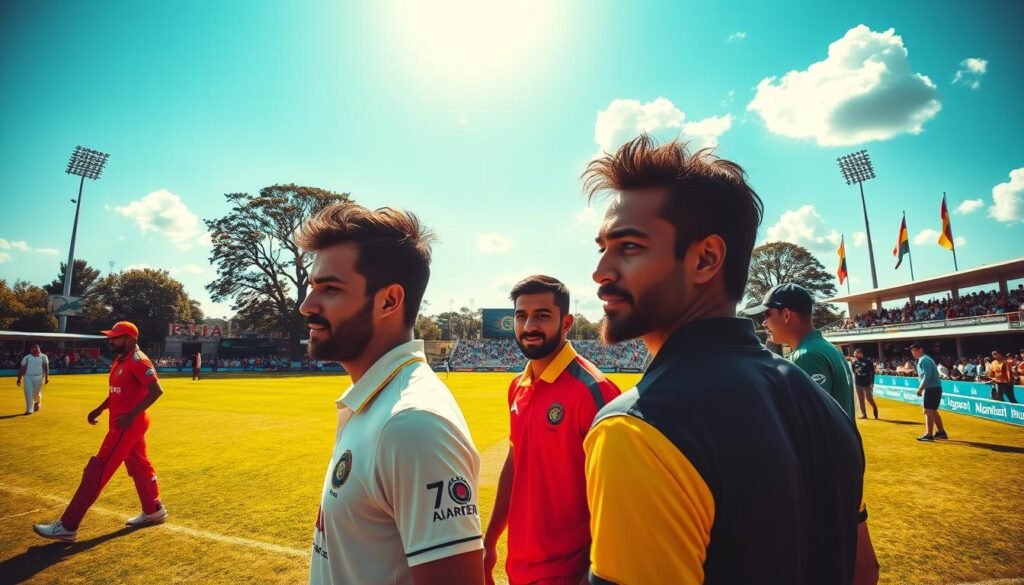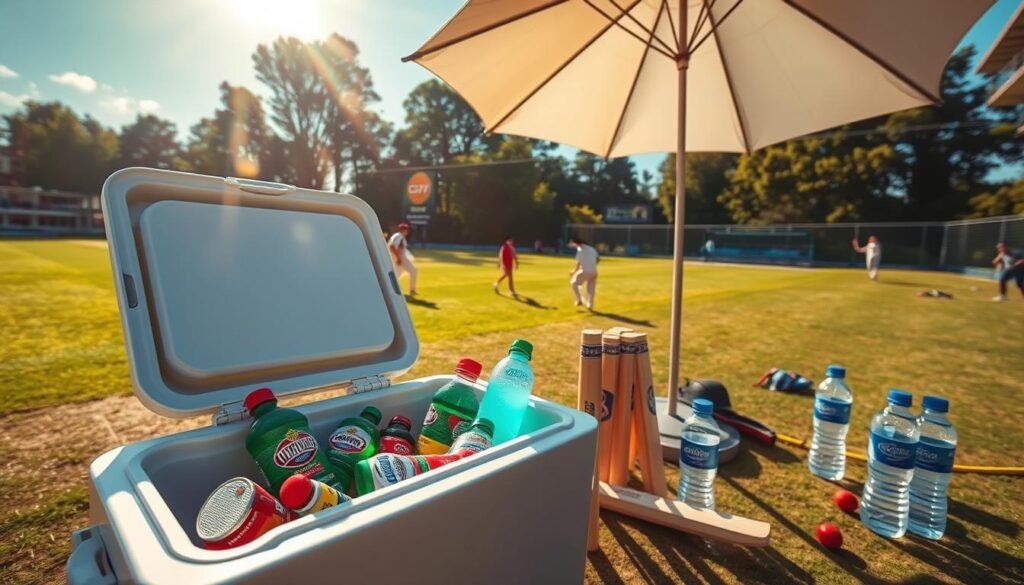Many athletes face the challenge of playing in the hot sun, especially in countries with warm climates. Cricketers must adjust their skills and strategies to perform well. They also need to manage the heat and UV exposure.
It’s important to know how cricketers handle playing in the sun. Their ability to do well depends on how they manage the heat. This article will look at how athletes stay cool and perform well in the heat.
Key Takeaways
- Cricketers are often exposed to intense sun, requiring effective heat management.
- Adapting to environmental conditions is key to success on the field.
- Hydration plays a crucial role in maintaining performance during hot matches.
- Proper sun protection measures are vital for players’ long-term health.
- Players utilize pre-game and in-game strategies to combat the heat.
Understanding Sun Exposure on the Cricket Field
Playing cricket means spending a lot of time in the sun. It’s important to know how this affects athletes. They face health and performance challenges due to sun exposure. It can lead to physical problems and long-term health risks.
The Effects of Sun Exposure on Athletes
Cricketers face many issues from too much sun. These include:
- Sunstroke: A serious condition that can cause headaches, nausea, and confusion.
- Dehydration: Losing too much water can hurt performance and increase heat illness risk.
- Long-term skin damage: Playing in the sun can lead to early aging and skin cancer risk.
UV Radiation and Its Risks
It’s crucial for cricketers to know about UV radiation risks. The sun’s ultraviolet rays can harm skin and eyes. Knowing the UV index helps players avoid the most dangerous times.
Being aware of sun exposure risks helps athletes stay safe. They can take steps to protect themselves, improving health and performance.
| Risk Factor | Symptoms | Prevention Tips |
|---|---|---|
| Sunstroke | Headache, nausea, dizziness | Rest in shade; stay hydrated |
| Dehydration | Dry mouth, fatigue, extreme thirst | Drink water regularly; use electrolyte solutions |
| Skin Damage | Burns, dark spots, aging | Apply sunscreen; wear protective clothing |
How Do Cricketers Fair Despite Playing in Sun
Cricketers spend long hours in the sun, facing intense heat. They have found ways to stay strong despite the challenges. Learning how they manage the sun’s heat helps us understand their toughness and ability to adapt.
Adaptation to Environmental Conditions
Getting used to the heat is crucial for cricketers. They slowly get their bodies ready for high temperatures. This helps them spot signs of heat illness early.
This approach is a key part of preventing heatstroke. It lets players keep up their performance.
Player Experiences and Strategies
Experienced players share useful tips for handling the sun. They use cooling towels, take breaks in the shade, and drink plenty of water. These strategies help them stay cool and focused during tough games.

Effective Heat Management Strategies
Managing heat is key for cricketers, especially in hot matches. Using good heat management before and during the game helps players perform well and stay healthy. We’ll look at important steps for getting ready before the game and managing heat during it. These steps help keep the body cool and hydrated.
Pre-Game Preparation
Before the game, players do several important things to fight off the heat. These include
- Physical Conditioning: Regular workouts build endurance and strength, helping players handle the heat better.
- Mental Warm-Up: Using visualization helps athletes get ready mentally for tough weather.
- Proper Nutrition: Eating a balanced meal with electrolytes helps keep players hydrated and energized.
In-Game Heat Management Techniques
During the game, players must watch their heat levels closely. Good ways to cool down include
- Fluid Intake Monitoring: Drinking water regularly is key. Teams have plans for how much water players should drink.
- Cooling Vests: Wearing cooling vests helps keep the body’s core temperature steady.
- Regular Breaks: Taking short breaks lets players rehydrate, cool down, and get their minds and bodies ready again.
These strategies are crucial for better performance and avoiding heat sickness. By focusing on good preparation and in-game methods, players can do well even in tough conditions. They can stay at their best on the field.
| Strategy Type | Examples | Benefits |
|---|---|---|
| Pre-Game Preparation | Physical conditioning, mental warm-up, proper nutrition | Improved endurance, mental readiness, enhanced hydration |
| In-Game Techniques | Fluid intake monitoring, cooling vests, regular breaks | Maintained body temperature, prevention of dehydration, sustained performance |
Hydration Strategies for Cricketers
Keeping well-hydrated is key for cricketers, especially when playing in the sun for long hours. It’s crucial to avoid dehydration to stay focused and perform well. Cricketers need good hydration strategies to stay on top of their game.
Importance of Staying Hydrated
Drinking enough fluids is vital for athletes, especially in sports like cricket. Players lose a lot of water through sweat during matches. Staying hydrated helps keep energy up, focus sharp, and physical strength intact. Without enough water, players can’t perform at their best.
Recommended Hydration Techniques
Using the right hydration methods can greatly improve a player’s performance. Here are some tips:
- Choose drinks with electrolytes to replace lost salts and minerals.
- Drink about 7-10 ounces of fluid every 10-20 minutes during play.
- Eat foods with lots of water, like fruits and veggies, before games.
- Check your urine color to see if you’re drinking enough water; it should be pale yellow.
| Hydration Technique | Benefits | Recommended Timing |
|---|---|---|
| Electrolyte Drinks | Replenishes salts, hydrates effectively | During match and practice sessions |
| Fluid Intake Schedule | Prevents dehydration, maintains energy | Every 10-20 minutes |
| Water-Rich Foods | Boosts overall hydration | Pre-game meals and snacks |
| Monitor Urine Color | Simple hydration level check | Throughout the day |

Sun Protection Measures for Cricketers
Cricketers spend long hours under the sun, making sun protection key. Using sunscreen is a big step in preventing skin damage from UV rays. Knowing the risks of skin cancer in cricket shows why prevention is crucial.
Key Sunscreen Application Tips
Choosing the right sunscreen is crucial for cricketers. Look for a broad-spectrum sunscreen with an SPF of at least 30. Here are some tips for proper application:
- Apply sunscreen generously to all exposed skin areas at least 15 minutes before heading outdoors.
- Reapply every two hours, or immediately after sweating or swimming.
- Don’t forget commonly overlooked areas like the ears, back of the neck, and tops of feet.
- Consider using water-resistant sunscreens when engaging in more intense activities.
Protective Gear and Clothing
Wearing protective gear is also key for sun safety. Clothes can block harmful rays. Some recommended items include:
- Wide-brimmed hats to shield the face and neck.
- UV-protective shirts and pants that can offer higher SPF protection than standard clothing.
- Sunglasses with UV protection to shield the eyes and surrounding skin.
Using these measures can greatly lower the risk of skin cancer in cricket. For more information, check out this informative article. Proper sun protection can greatly improve athletes’ health in the long run.
Conclusion
Managing sun exposure is key for cricketers aiming to perform at their best. UV radiation can harm health, so it’s vital to manage heat and protect from the sun. By staying hydrated and using sun protection, players can play better without sunlight’s effects.
Clubs and coaches must teach players about staying hydrated and protecting themselves from the sun. This knowledge helps players perform well, even in tough conditions. Learning about these topics can improve endurance and overall performance.
Being able to play well in the sun shows how important preparation and adaptability are. With the right strategies, players can not only survive but excel under the sun. This sets the stage for success in every match.








